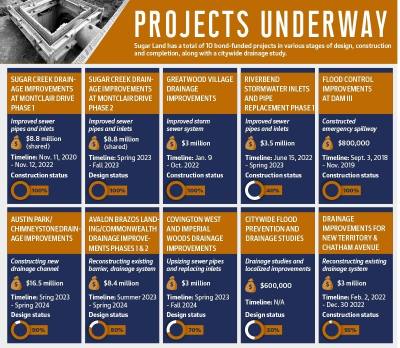Sugar Land voters approved a $90.76 million general obligation bond in November 2019, which included $47.6 million for drainage under Proposition A. Three years later, following a pandemic and rising construction costs, the city has checked four of 10 projects off the list.
When the city was developing the bond, drainage stood out as a top-priority need, City Engineer Jessie Li said, with those areas that flooded during Harvey taking top priority.
An additional concern arose over street ponding, which hindered emergency responders and people’s ability to travel.
The city also conducted drainage studies prior to the bond in 2013 and following Hurricane Harvey and created the Integrated Stormwater Management Model, which can model the drainage performance throughout the city’s system. The model allows staff to input a quantity of rain over time, such as 6 inches per hour, and see how the city’s system will perform.
“We used all of that to inform our decisions on developing the bond election. And year after year, what we’ve seen as priorities from our citizens are drainage and mobility,” Sugar Land Communications Director Doug Adolph said.
Li said through the combination of resident input, the drainage study and modeling—prioritized by need and what the city could afford—the city decided on the 10 projects to pursue. The projects were listed on the ballot during the November 2019 election, which garnered 71.28% approval from voters. Sugar Land now has another opportunity to address flooding concerns with an allocation of $4.1 million in federal funding from the Houston-Galveston Area Council and a partnership with Fort Bend County for a share of its $56.03 million allocation.
Progressing through projects
Since 2019, Li said the city has made “significant progress” on those drainage projects. Four of the 10 have been completed, and the city has made design progress on the remaining six. The city is preparing to go out for bids for Phase 2 of Sugar Creek drainage improvements at Montclair Drive in early 2023, she said. The $5.5 million project will upsize existing storm sewer pipes, outfall and inlets along with pavement replacement along the entire stretch of Montclair Drive.
While the bond passed in November 2019, the money did not become available until October 2020. So far, Phase 1 of Sugar Creek drainage improvements at Montclair Drive, Greatwood Village drainage improvements, flood control improvements at Dam III, and drainage improvements for New Territory and Chatham Avenue have been completed. “Those projects definitely reduced the flood risk for our residents in identified areas,” Li said.
Two years later, the city has the same goals: meeting its performance criteria, including no structure flooding, reduced street ponding with one lane drivable and flooding during a 100-year flooding event not exceeding 9 inches above the curb. A 100-year flooding event is a flood that statistically has a 1% chance of occurring in any given year.The city has received positive feedback from the completed projects, Li said.
“We’ve already seen some of this during significant rain events we’ve had since that time,” Li said.
Li said she anticipates the second round of improvements in the bond package will have similar results.
Facing the challenges
Since the bond’s approval in 2019, the city has run into challenges: increasing costs and the pandemic.
Rising costs for concrete, steel and labor have changed the project cost estimates since 2019.
The producer price index, which measures changes in selling prices over time received by producers, shows a 25% increase in the price of concrete since November 2019 and a 78% increase in the price of steel.
Li said the city responds to this on a case-by-case basis. However, the city took advantage of low prices after Harvey and began work on the now-completed drainage projects. The city is then able to use those savings to compensate for increased costs for projects still in the design phase.
The pandemic also had an economic impact on Sugar Land residents, Adolph said. The city authorized an increase in the property tax rate prior to the pandemic, and many residents faced financial hardship during this time, Adolph said.
This impacted the delivery schedule for the projects. The city had anticipated moving forward more quickly with the bond projects but instead had to extend the schedule.
The city did not raise the entire amount of the $0.03 tax rate increase voters authorized, Adolph said. The tax rate pre-election was 33.2 cents, with an estimated $0.03 increase from the GO bonds. The city’s tax rate is 34.65, so it has used $0.0233 of the $0.03.
Funding future needs
With the 2019 bond projects underway, Sugar Land is looking to a new source of funding for flood mitigation.
In August, the H-GAC approved a method of distribution for $488 million in Community Development Block Grant mitigation funds from the U.S. Department of Housing and Urban Development for the cities and 13 counties it serves.
HUD provides the mitigation funds as part of its Regional Mitigation Program. The Texas General Land Office administers the program at the state level and sets guidelines for how regional governments distribute funds.
The H-GAC allocated Sugar Land nearly $4.1 million in federal funds. The GLO approved the H-GAC’s method of distribution Sept. 6, and entities that received an allocation have until Jan. 9 to develop an application and submit it to GLO.
“We don’t have a real great sense yet on how long it’s going to take once they get an application in to review that application, contact the entity about any revisions and then actually get a contract in place with that entity,” H-GAC Principal Planner Justin Bower said.
Sugar Land officials said the city plans to use the allocation to address erosion along the Brazos River and partner with Fort Bend County to draw from the county’s $56.03 million allocation. Li said Sugar Land’s allocation alone is not enough to fund the project.
The city’s allocation amount will not change but it must now get an eligible project approved. The city is applying for funds and will have a resolution before City Council in December, Li said. Since funding comes from a federal grant, there is no matching requirement. The timeline is uncertain, but Bower said it could be mid-2023 before Sugar Land sees the funding.
The city also set aside $600,000 from the bond for a drainage study to identify needs in preparation for its next bond election, which it is still discussing. Li said the study, which is underway, will likely be completed in Spring 2023.







